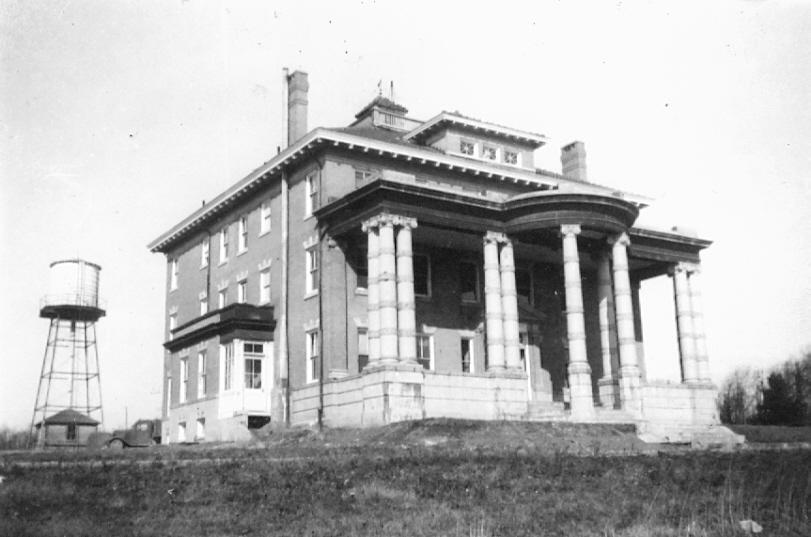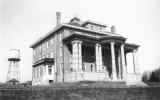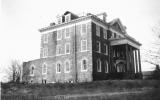CPS Unit Number 114-01
Camp: 114
Unit ID: 1
Title: Mount Weather
Operating agency: BSC
Opened: 9 1943
Closed: 6 1946
Workers
Total number of workers who worked in this camp: 115
-
 CPS Camp No. 114, Mount Weather Bluemont Virginia.The men live in this building, designated as the "summer white-house". We live five-to-a-room on the Second and Third floors. There are four tiled bathrooms on each floor - carpeted stairs and halls. The infirmary, kitchen, dining room, library and living room are on each floor. There's a wide-open view of the beautiful valley 1500 feet below from the front porch.Digital Image © 2011 Brethren Historical Library and Archives. All Rights Reserved.
CPS Camp No. 114, Mount Weather Bluemont Virginia.The men live in this building, designated as the "summer white-house". We live five-to-a-room on the Second and Third floors. There are four tiled bathrooms on each floor - carpeted stairs and halls. The infirmary, kitchen, dining room, library and living room are on each floor. There's a wide-open view of the beautiful valley 1500 feet below from the front porch.Digital Image © 2011 Brethren Historical Library and Archives. All Rights Reserved. -
 CPS Camp No. 114, Mount Weather Bluemont Virginia.Project work is conducted on the first floor of this "lab" building. Offices and additional work rooms are on the second floor. Third floor will be used for living quarters if unit is expanded. This is about 70 yds. from the dorm building. The front faces the sides of the dorm building.Digital Image © 2011 Brethren Historical Library and Archives. All Rights Reserved.
CPS Camp No. 114, Mount Weather Bluemont Virginia.Project work is conducted on the first floor of this "lab" building. Offices and additional work rooms are on the second floor. Third floor will be used for living quarters if unit is expanded. This is about 70 yds. from the dorm building. The front faces the sides of the dorm building.Digital Image © 2011 Brethren Historical Library and Archives. All Rights Reserved.
CPS Unit No. 114, a Weather Bureau unit located on Mt. Weather near Bluemont, Virginia and operated by the Brethren Service Committee, opened in September 1943 and closed in June 1946. Men collected and charted weather data and performed maintenance at the station.
This was the only CPS unit working with the Weather Bureau, an agency within the Department of Commerce.
The unit was located on Mount Weather, not far from Bluemont in the northernmost part of Virginia. In the Blue Ridge Mountains on Virginia Route 7, Bluemont was a very small community at the base of Snicker’s Gap.
Directors: Homer Bonhivert, Allen R. Kaynor, Ned B. Carmean
Leonard B. Corwin from the Weather Bureau served as Camp Director, working with the Brethren assigned assistant directors listed above. In addition, Lewis Beikford, a Methodist and graduate of Clarke College directed a camp chorus.
“The sixty-odd men at Mt. Weather come from eighteen states and represent twenty-one denominations. The average age is twenty-five, and the median education is three and a half years of college. “(Miscellaneous article by Bill Wallace, March 7, 1944) The unit at one point filled its quota of seventy-five men.
The men collected and charted weather data and performed maintenance functions at the station
Men in the unit completed 31,000 person days of work during the three-year life of the unit. (as reported by the Camp Operations Division of Selective Service and recorded in Table VI, Civilian Public Service Projects in Sibley and Jacob pp. 126-127)
Of the 68 campers, “16 were engaged in coding of synoptic data for the South West Pacific Maps, and the balance detailed to various other overhead and rehabilitation projects.” The men rehabilitated the director’s living quarters and renovated the camp buildings. The primary work, however involved “much copying of certain weather data from original forms or facsimilies onto tabulating sheets of more suitable format for the machine statistician’s use.” (Robert Thom)
According to the Gospel Messenger, “after-work activities consisted of meteorology study, glee club, baseball, study of co-operatives and a Russian language class” (October 24, 1944)
The men occupied a three story masonry structure, where they lived, ate and were hospitalized as necessary. With six rooms on each of the two upper floors and four tiled bathrooms per floor, the rooms accommodated five men per room. The first floor included the infirmary, kitchen, living and dining rooms and library. (Bill Wallace)
A committee on religious activities initiated weekly services on Sundays and Tuesday evenings. According to a CPS report on the camp, several churches proved openly friendly and ministers nearby often led services.
There is a small library in the dormitory, and the Percellville, VA travelling library has established a station here. They have a remarkable selection for so small a town, and regularly leave 70-80 books for periods of a month or more. The unit receives The Washington Post, and recent issues of many periodicals are always available in the library. A credit union and a co-op store have been organized. The recreation committee has fixed up a volleyball court in the balloon shed, and evening football is a regular thing. (April 1, 1944 report)
Walt Neave, sent the following letter on December 15, 1945.
. . .Mt. Weather and I are getting on very well. The project is entirely different from anything I ever did before but it might be useful later to know how to use office machines. We check over weather data from all parts of the world, correct mistakes in computed figures and send the papers to Washington.
One very attractive feature of the project is the advantage of living and working in steam-heated buildings; but there are less attractive sides too. There are the sarcastic comments about this being “work of national importance” here too, and the general opinion seems to be that three months of this is about all one person can take without getting sour.
For more information on Brethren units see Leslie Eisan, Pathways of Peace: A History of the Civilian Public Service Program Administered by the Brethren Service Committee. Elgin, IL: Brethren Publishing House, 1948.
See also Mulford Q. Sibley and Philip E. Jacob, Conscription of Conscience: The American State and the Conscientious Objector, 1940-47. Ithaca, NY: Cornell University Press, 1952.

